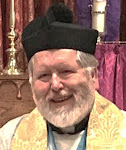This is the richly decorated ceiling of Santarém Cathedral, Portugal,
built in the 17th century and featuring
the Assumption of the Blessed Virgin Mary.
Today is one of the truly GREAT days of the Church’s year. We celebrate the Blessed Virgin Mary “our tainted nature’s solitary boast"(Wordsworth) coming to the end of her earthly life and being reunited with her Son, Jesus, sharing the completeness of his resurrection victory.
In 1996 at All Saints’ Wickham Terrace, Brisbane, we recorded our High Mass of the Assumption. Sadly, although we paid for professional expertise, the result was unusable because the microphones were too close to the organ pipes. The following year (1997) just before Mass began, as an afterthought I turned on my pocket dictation recorder and put it near a window well away from the organ. The result isn’t professional, and it’s scratchy in places. But not long ago I found the tape and converted it to digital format. It does capture the atmosphere of our celebration, and I’ve put a link to it below, mainly as a treat for those readers - now literally all over the world and in all sorts of churches - who were part of our parish community in those days. Enjoy a trip down Memory Lane! The Mass is sung to Schubert's "folk setting", his Deutsche Messe. You will hear the historic T.C. Lewis organ (before its restoration), as well as the stringed instruments. The readings and other inaudible parts of the recording have been edited out. I am the celebrant, David Barkla the organist and director of music, and Churchwarden Lorraine Hines reads the Prayers of the Faithful. Click on the link:
The following paragraph from the Preface for the Mass of Our Lady, Mother of Divine Hope, is a perfect reflection for today, as it so beautifully expresses the way we now see our relationship with the Lord’s Mother:
Mary, the fairest fruit of Christ’s redeeming love
is a sister to all the children of Adam
as they journey toward the fulness of freedom
and raise their eyes to her,
the sign of sure hope and comfort,
until the day of the Lord dawns in glory.
In Mary Daughter of Sion, Lucien Deiss explains how Mary is a “prefiguration” of the Church:
There can be no doubt that the idea of divine protection is what John is evoking when he writes that the Woman flees into the wilderness unto her place. In her flight away from the serpent, the Woman does not wander about at random, but on the contrary, she seeks refuge in a safe haven, in the place that God has prepared for her.
It is interesting to note that the verb to prepare is the one usually found in those texts which refer to the eschatological realities that God is making ready for the faithful. As a matter of fact, the expression to prepare a place, in the only other instance that it does occur in John, will be found in a similar context:
In my Father’s house there are many mansions. Were it not so, I should have told you, because I go to prepare a place for you. And if I go and prepare a place for you, I am coming again, and I will take you to myself; that where I am, there you also may be.
These ideas manifestly recall what we read in the Apocalypse: Christ is returning to his Father, a reference, most certainly, to the mystery of his passion, resurrection, and ascension, namely, the very mystery of his own Exodus, his passage from this world to the Father.
Here again Mary is a prefiguration of the Church. The place in the wilderness that is prepared for the Church conjures up the image of the eternal dwelling-place into which she enters on the morning of her Assumption.
In reascending to his Father, the Child was preparing a place for the disciples who make up Mary’s second posterity. Without waiting for the Day of the general resurrection, his mother is awarded her share in his destiny At the same time she is also the prefiguration of what in the normal course of events has been reserved for the end of the world, when the pilgrim Church will be assumed into the glory of the new Jerusalem.
Mary stands in the vanguard of the Church on its march toward the kingdom. In her, the desert Church that is still battling against the Dragon has already reached the shore of eternity. In her, she already contemplates, in joy and peace, the eternal face of God.
And these words from Kairos Magazine, (Melbourne, Aust, Volume 20, Issue 14) express the same truth in a different way:
Our response to God has not been as whole-hearted as Mary’s, but we too, like her, have borne the Son of God in our hearts. We have received him in the gift of the Eucharist and we are the bearers of his promise that “those who eat my flesh and drink my blood have eternal life, and I will raise them up on the last day” (John 6:54).
In celebrating Mary’s assumption into heaven we do not celebrate something which places Mary apart from us. Rather we celebrate something which places Mary among us as the first to receive the gift of salvation in all its fullness, a gift which the Lord also holds out to us. May this woman, given to us by Christ as our mother, be our companion on our journey of faith. May she, through her prayers and her presence in our lives, accompany us until we share with her the joy of salvation, body and soul, in the glory of heaven.


















0 comments:
Post a Comment